Sex toy cleaners. You’ll see them in every brick-and-mortar sex shop and online store. They’re a regular and easy add-on to most vibrating purchases. They’re also labeled as a “must” for sex toy cleaning and care (even I have recommended them).
However…
I was shocked to find there wasn’t much out there that took a close, hard look at what we’re slathering on our dildos, butt plugs, and bullet vibes. So, if you love your toy chest and want something safe for your body, here is an in-depth look at 15 brands and what’s in them…
IMPORTANT DISCLAIMERS
#1. I’ve done my best to do as much research as possible and break things down to be simple to understand, so you can make an informed purchase.
However…
#2. This isn’t a soft or “light-read” article. There’s still a lot of information to digest (especially if you want to go through the ingredient glossary).
#3. The available data is mostly from shampoos, moisturizers, and cosmetic research papers or guides. I haven’t been able to find any data on these ingredients specifically in relation to sex toy cleaners.
This is tricky because, while cosmetics and lotions stay on the skin, sex toy cleaners should be completely washed off. And, if the toy is nonporous, there should (in theory) be no absorption or left-over residue. This means that the warnings attached to creams, lotions, makeup, etc., might not apply to cleaners.
Then, there are your personal feelings and how extreme of a safety zone you want to have.
So, grab a cup of your favorite beverage, and prepare to get semi-sort-of-sciencey…
If you want to skip EVERYTHING and go straight to the product list
WHAT’S IN SEX TOY CLEANER?
You’ll find that these ingredients serve one (or more) of these main functions…
CLEANSER – Taking away bacteria and oils etc.
BACTERIA FIGHTER – Aside from helping clean, these ingredients can also act as a preservative for the mixture itself (any natural materials plus water will break down and grow bacteria, hence the need for a preservative).
EMULSIFIER– Helps liquids mix together better
SURFACTANT – Lowers the surface tension between liquids
FOAMING AGENT – Makes more bubbles
Also, in many advertisements, you’ll see claims of “soothing” and “moisturizing” ingredients. For example this is from one of the 15 products I looked at…

This is complete horse crap.
While the ingredients might actually “sooth” your skin (and sound like fantastic additives), these cleaners should be rinsed off right after you’re done washing your (nonporous) sex toy – just like you would rinse off any soap or a 10% bleach disinfectant. There’s ZERO reason for them to stay on the toy during use. Yeah, my hands will get softy-smooth, but my hoohaw should not.
Therefore, any promises of hydrated skin are pointless and nothing but a sales gimmick.
“So, what about the bad ingredients? Don’t they washed off?”
Glad you asked.
While moisturizers mean nothing, BAD additives (especially irritants) could cause problems when they come in contact with your skin as you wash the toy. Also, there are those with concerns about parabens and other things that might be “harmless” in small doses, but, when you add up how many products you’re exposed to on a daily basis, the total could be a level of exposure you don’t want for yourself.
And let’s not forget the fact that not everyone cleans their toys as thoroughly as they should.
So, while “skin-soothing” residue doesn’t hurt, it’s best to err on the side of caution when it comes to risky or unknown ingredients.
SAFETY CLASSIFICATIONS
I’ve compiled ALL the ingredients you’ll find in the 15 sex toy cleaners on this list. I’ve included what they’re used for in the cosmetic and skincare industry, what they’re made from (if I could find it), any warnings or disclaimers, and if they are…
- SAFE– No real dangers that can be found or comes from natural materials.
- ACCEPTABLE – Seems to be alright to have as an ingredient (as far as current data or provided information can prove). BUT, it needs to be within acceptable limits. You might need to exercise personal discretion.
- QUESTIONABLE – Conflicting or lacking data or too many variables to promise safety.
- BAD – Proven dangerous substance or too much negative data or warnings.
REMINDER: These “safety labels” are looking at the materials for SEX TOY CLEANING (stuff you’re going to thoroughly rinse off), not about cosmetics that will stay on your skin for hours or days.
INGREDIENT LIST
CLICK HERE, if you want to skip the (very long) ingredients list and come back to it later.
ALLANTOIN – Safe
A naturally occurring nitrogenous compound – the synthetic version is non-toxic and widely used in lotions and skin care products. Soothing, moisturizing, and anti-irritating properties.
ALOE BARBADENSIS LEAF EXTRACT – Safe
Also known as Aloe Vera, it’s beneficial for it’s soothing and healing properties. It’s also an emulsifier. However, current studies are trying to decide if the “non-decolorized” leaf extract is safe for ingestion. Since this relates to sex toy cleaner, it shouldn’t be an issue.
ALTHAEA OFFICINALIS ROOT EXTRACT – Safe
Also known as Marshmallow Root. Highly beneficial for internal and external use (for a wide variety of ailments).
AMMONIUM LAURYL (or DODECYL) SULFATE – Acceptable
Used as a foaming agent as well as a cleansing agent (helping water mix with oil to make things easier to wash). It’s an irritant in high concentrations, however, anything under 1% is considered a “safe” level. Also, you’ll see some “ingredient watch list” blogs classify this as dangerous, but that is regarding cosmetics.
AVENA SATIVA (OAT) KERNEL EXTRACT – Safe
Used to protect skin and provide relief. Commonly found in skin care and bath products.
BENZALKONIUM CHLORIDE (BAC) – Acceptable
A surfactant and antibacterial agent/preservative. It’s also commonly found in household cleaners. Can be irritating to the skin if the concentration is too high. It seems the ideal concentration (to stay within safety limits) is 0.1%.
BENZYL ALCOHOL – Acceptable
Benzyl alcohol is a naturally occurring and synthetic ingredient used as solvent and preservative. It’s used in a wide variety of product. The concern comes from regular exposure to high percentages. The EU has allowed it in cosmetics under 1%.
BUTYLENE GLYCOL – Avoid
Derived from petroleum, it acts to make sure creams and liquids don’t dry out as quickly. Can cause irritation through regular exposure.
CAPRYLYL GLYCOL – Safe
It’s an alcohol derived from caprylic acid—a natural fatty acid found in the milk of some mammals, as well as palm and coconut oils. It’s a conditioner and moisturizer. It also increased the antimicrobial activity in other preservatives. While some glycols can be harmful, Caprlyl Glycol is fine.
NOTE: If you see the ingredient “Optiphen” it means it’s a combination of Caprlyl Glycol, Chloroxylenol and Phenoxyethanol.
CHAMOMILLA RECUTITA (MATRICARIA) FLOWER EXTRACT – Safe
AKA. German chamomile – the stuff you put in tea. Used as an anti-inflammatory and antiseptic, and skin-conditioning agent. Common. Harmless.
CHLORHEXIDINE GLUCONATE – Acceptable
An antibacterial cleansing agent – commonly found in some prescribed mouthwashes. Used in hospitals and dental clinics.
CITRIC ACID – Safe
In proper/negligible concentrations, it’s fine. I have heard of those suffering from severe corn allergies (I didn’t know that was a thing), need to be careful that the citric acid hasn’t been taken from this vegetable.
COCAMIDE DEA – Questionable
A foaming and emulsifying agent. A possible irritant for some people. Although the FDA has approved Cocamide DEA within small percentages, some avoid it because animal testing has shown negative results. However, others would argue that reactions to rats are not the same for humans.
COCAMIDOPROPYL BETAINE – Acceptable
A derivative from coconut oil – but the ending result is synthetic. Used as a thickener and to create more foam. Generally considered safe but can cause skin irritation in a small percentage of people. Do a spot test if the cleaner contains this.
COCAMIDOPROPYL HYDROXYSULTAINE – Acceptable
Similar to Cocamidopropyl Betaine
CUCUMIS SATIVUS (CUCUMBER) FRUIT EXTRACT – Safe
Comes from normal cucumbers. Common and useful in skincare products.
DECYL GLUCOSIDE – Safe
A vegetable derivative used as a surfactant. Good for cleaning and foaming products. Common, non-irritating, non-allergenic.
DENATURED ALCOHOL – Acceptable
AKA. Methylated spirit or denatured rectified spirits
Denatured alcohol means it’s been “made undrinkable”, usually for industrial purposes. It’s used to make creams feel lighter and as a preservative. There are fears that alcohol is bad for the skin, but we’re not putting this on our skin.
DISODIUM COCOAMPHODIACETATE – Acceptable
A surfactant and foaming agent. Considerable data says it’s acceptable for cosmetic use, however, there are a few personal or “natural” blogs that protest it as dangerous.
DISODIUM EDTA – Questionable or Avoid
EDTA stands for “ethylenediaminetetraacetic acid”. It is synthesized from ethylenediamine, formaldehyde, and sodium cyanide. Disodium EDTA is the salt produced as a result. There are conflicting arguments about if it’s safe or not. If you’re wary, best to avoid.
DISODIUM LAUROAMPHODIACETATE – Questionable
Surfactant, cleansing agent, and foam booster. Limited data.
DIAZOLIDINYL UREA – Avoid
AKA. DMDM Hydantoin
An antimicrobial preservative and PH balancer. Proven formaldehyde releaser and highly controversial additive (possibly carcinogenic). Despite “safe limits” being less than 0.5%, (0.05% in Europe) doctors and specialists recommend avoiding it, if for no other reason than the possibility of irritation.
ETHYLHEXYLGLYCERIN – Questionable
A surfactant and preservative used instead of parabens. It’s been proven in two cases/studies to be a possible irritant and to be avoided if you have skin sensitives. It might not be the best preservative, but it’s better than others. Allergy warning.
FRAGRANCE – Avoid
The problem with “fragrances” is that it can mean anything. Anything. There’s literally no way to know what they’re putting in or if you’re going to be allergic to it. Besides, there’s no need for fragrances in your sex toy cleaner. As long as your cleaning your nonporous toys properly, there should be no leftover smells.
GLYCERIN – Acceptable
Also known as Glycerol, is a naturally occurring sugar alcohol. There are extreme debates whether it’s safe or not. However, this will be going on your sex toys, not your skin. So, it should be okay.
HEAMIDINE (HEXAMIDINE) DIISETHIONATE – Safe
Used as a preservative/bacterial killer. Long track record of useage for mild or saftey products.
HYDROXYETHYLCELLULOSE AKA. “HEC” – Safe
It’s a plant-derived amino acid (from cellulose, a very common natural ingredient) and is used as a preservative, emulsifier, binder, and thickener.
LAUYLDIMONIUMHYDROXPROPYL DECYGLUCOSIDES CHROIDE – Questionable/Avoid
I couldn’t find this by their spelling on the bottle. The closest thing I could find was “Stearyldimoniumhydroxypropyl Decylglucosides Chloride” which is a cleansing agent, emulsifying agent, skin conditioner, surfactant, and a mouthful to pronounce. Not enough data.
LAURYL GLUCOSIDE – Safe
Sounds bad, but it’s not. It’s a mile surfactant and great foaming agent derived from coconut and sugar.
LAVANDULA ANGUSTIFOLIA – Safe
This is Lavender essential oil. Ver common, useful, and fine to have as an ingredient -antibacterial, antifungal, and soothing.
LEPTOSPERMUM PETERSONII – Safe
Another essential oil – Lemon Tea Tree. Like lavender, great for bacteria-fighting.
MELALEUCA ALTERNIFOLIA – Safe
Regular Tea Tree essential oil. Natural and a great bacteria fighter.
METHYLCHLOROISOTHIAZOLINONE – Questionable
Used as a preservative. However, even though studies have not proven it causes cancer, there are concerns about skin irritation or allergies. It’s approved (in low percentages), but it’s still recommended to avoid if you have sensitive skin.
METHYLISOTHIAZOLINONE – Avoid
A preservative and bacterial fighter. Irritation and allergic reaction warnings. Some countries have banned it.
METHYLPARABEN – Questionable
Used as a preservative. It’s worth noting that “Parabens” are at the center of a large debate right now – with many people choosing to avoid them altogether (because if low percentages are “okay” but we use a lot of products that contain them, these percentages are no longer “low”).
There’s a lot of ongoing research to show if they can be linked to cancers, however, data is still being compiled. Methylparaben is apparently easily absorbed into the skin but is easily eliminated as well. At your discretion, if you want to avoid parabens altogether.
NEOHESPERIDIN DIHYDRO CHALCONE – Questionable
This is artificial sugar. In and of itself, it’s safe and a common food additive. BUT, why is there sugar in sex toy cleaner? Until someone can explain this, I’m keeping it as “questionable”.
OLEFIN SULFONATE – Acceptable
AKA. Sodium C 14-16 Olefin Sulfonate or Sodium C14-16
Used as a surfactant, it’s derived from either coconut or petroleum. Generally safe within small percentages.
PANTHENOL – Safe
An emollient and moisturization derived from vitamin B5. Common in many skincare products.
POLYETHYLENE GLYCOL – Avoid
AKA. “PEG 8”
PEGs are in many cosmetics. In general, they are emollients (help soften and lubricate), emulsifiers (help water-based and oil-based ingredients mix properly), and a vehicle that helps deliver other ingredients deeper into the skin, or a thickener.
There are indications that the impurities that are associated with the PEG family can be cancer-causing. However, research and data are conflicting and ongoing. If you have skin problems, it’s best to avoid this product. Natural glycols are a good alternative to PEGs. For example, natural vegetable glycerin.
PEG-12 DIMETHICONE – Avoid
Although PEG 12 and 7 (among others) are considered “safe” for rinse-off products, there is still the risk of “1,4-dioxane” impurities, which can cause cancer. Essentially, it can be safe if it’s treated properly, but there’s no way to know from ingredients are made correctly. That’s why it’s best to avoid them.
PEG-7 GLYCERYL COCOATE – Avoid
Same for other PEGs.
PENTYLENE GLYCOL – Questionable
AKA. “PG”
Derived from petroleum, this additive acts as a humectant, which helps retain moisture by helping the ingredients penetrate the skin faster. It can also be used for its anti-microbial properties. However, it’s also classified as a skin irritant.
PHENOXYETHANOL – Acceptable
AKA. “Ethylene Glycol Monophenyl Ether”
This is a “newer” compound in the additive world and is used as a preservative substitute for parabens and formaldehyde-releasing compounds (which are bad). Preservatives are essential for stopping bacterial growth in water and nutrient-rich mixtures.
In high doses, it can be irritating, drying, and damaging to the skin and lungs. However, it’s shown to be relatively harmless in small doses. Europe (which is far stricter than the USA with its food/health laws) has approved it as an additive but only under 1%.
PHOSPHOLIPID – Safe
A naturally occurring complex lipid that contains glycerol, two fatty acids, and a phosphate group. Can be used as an emulsifier, a liposome former, a solubilized, and a wetting agent. Data seems to suggest there are no dangers.
POLOXAMER 184 – Safe
A surfactant and cleansing agent. Several papers suggest it’s fine, with no known toxic or allergic issues.
POLYGLYCERYL-4 CAPRATE – Safe
Derived from glycerin and a fatty acid. It is commonly used as an emulsifier or surfactant. It doesn’t show up on any warning guides etc.
POLYSORBATE 20 (or 40) – Questionable
AKA. “Sorbitan”
Used as a surfactant, emulsifier, and fragrance. The first stage of this ingredient is natural (it comes from sorbitol, a sugar alcohol). HOWEVER, Polysorbate 20 is NOT a natural ingredient because “20” parts of ethylene oxide are added.
Despite being listed as a “low hazard ingredient” and has a low risk of skin irritation, if the ethylene oxide has contributed to a contamination of “1,4-dioxane”, it becomes a dangerous, cancer-causing additive. There are natural alternatives, however, I don’t know if they’re applicable to sex toy cleaner mixtures.
POTASSIUM SORBATE – Safe
Used as a mild preservative and alternative for parabens. There is a small chance of irritation for those with sensitive skin, but it’s been deemed safe by several sources.
PROPYLENE GLYCOL – Acceptable
A humectant, preservative, or stabilizer. Fears of it being the same as antifreeze only applies to a different version of this additive – not the version used in cosmetics. However, there are still (unconfirmed) concerns about cancers etc.
PROPYLPARABEN – Avoid
Used as a preservative. Labeled as a moderate/high-risk ingredient. Like, other Parabens, there are worries (an ongoing studies) regarding cancer.
SODIUM BENZOATE – Safe (with a disclaimer)
AKA. E211
A preservative and anti-fungal, the ingredient (in and of itself) is harmless. However, when mixed with Vitamin C or ascorbic acid, it (under certain circumstances and, I think, with the presence of metal) has the chance of forming a by-product of benzene (which is linked as a cancer-causing agent). Watch your ingredients list to make sure they’re not together.
SODIUM CARBOXYMETHYL LAURYL GLUCOSIDE – Safe
AKA. SLS (note, there are two “SLS”s in the chemical world)
A cleansing agent derived from coconut. However, there’s little information to be found on it. The little there is suggest it’s safe.
SODIUM CHLORIDE – Safe
Commonly known as table salt. Has several uses. Nothing to worry about.
SODIUM CITRATE – Safe
This is a salt derived from citric acid. Antioxidant, preservative, and PH balancer.
SODIUM LAUROYL SARCOSINATE – Questionable
A cleanser and foam booster. NOT the same as sodium lauryl sulfate. There are concerns about nitrosamine (known carcinogen) contamination. If the ingredient is pure/treated properly, it’s safe. If not, or it’s exposed to unknown conditions, it’s a hazard.
SODIUM LAURYL SULFATE – Questionable
A cleanser and foaming agent. There is the 1,4-dioxane cancer concern. However, remember, if treated properly, there’s no risk. Lush products, for example, treat their SLS with an extra process to take care of this problem. I’ve labeled it as “questionable” because we don’t know how sex toy cleaner SLS is treated.
SODIUM PCA – Safe
A naturally occurring humectant found in human skin that is a derivative of amino acids. No warnings or health concerns.
SODIUM TRIDECETH SULFATE – Safe
A cleansing product as well as an emulsifying, foaming, and surfactant. No warnings or health concerns.
SORBITOL – Safe
A sugar alcohol derived from corn. Acts as a humectant. No warnings or health concerns.
SUCRALOSE – Questionable
It’s … artificial sugar…? Why is sugar is a sex toy cleaner? Fragrance perhaps? Seems unnecessary.
TETRASODIUM EDTA
A formula preservative. Cosmetic Database classifies it as a moderate hazard. Some choose to avoid it because there’s still ongoing testing. But it’s already been proven to not be a carcinogen. But things are still up in the air about this ingredient.
THYMOL – Questionable
An antifungal preservative. Classified as a mild irritant to those with sensitive skin.
TOCOPHEROL – Safe
A compound related to Vitamin E. Used as an anti-oxidant. Common and no notable risks.
TOCOPHERYL ACETATE – Acceptable
Similar to Tocopherol, but with a slight increase in the chance for skin irritation.
TRICLOSAN – Questionable
An antimicrobial agent found in a wide variety of antibacterial soaps and detergents. There are ongoing studies to see if this is long-term safe.
TRIETHANOLAMINE – Avoid
A reactionary by-product of two toxic substances: ethylene oxide and ammonia. Used as a PH balancer and emulsifier. Classified as a moderate hazard with ongoing studies.
TRISODIUM ETHYLENEDIAMINE DISUCCINATE – Safe
Seems to be (in general) a formula stabilizer and a salt derivate of the base chemical. Several pages of data with no warnings.
WATER (AQUA) VS. DEIONIZED WATER – Safe
It’s used to dilute formulas etc. Water/Aqua might just be water, but there can still be impurities if it’s not distilled correctly. Deionized water is highly purified water (more than distilled) and only contains no ions other than H+ and OH-. Deionized water is Safe. Distilled water is Safe. Unspecified water is Acceptable or Questionable, depending on how paranoid you are.
ZINC ACETATE – Acceptable
It’s the zinc salt of acetic acid. It functions as an astringent and antimicrobial agent. Seems to be acceptable as long as it’s under a percentage limit. Limited data with cosmetics.
ZINC GLUCONATE – Acceptable
Bacteria-killing agent. Cosmetic Database considers this a moderate hazard (meaning you have to be more careful with it) – even though you find it in several acne medications, they restrict it to less than 100mg a day. I can’t see sex toy cleaner containing significant amounts and you wouldn’t be using it that often.
ZINC LACTATE – Acceptable
Not a lot of relevant data to be found. Seems to be an anti-microbial and classified as a low-hazard additive.
15 SEX TOY CLEANERS & WHAT’S IN THEM…
INGREDIENTS: Water (Aqua), Cocamidopropyl Betaine, Propylene Glycol, Phenoxyethanol, Benzalkonium Chloride, Zinc Gluconate
NOTE: After compiling the list I found that THREE other brands shared the exact same recipe – #LUBELIFE, JO REFRESHING FOAM, AND PINK CHERRY UNSCENTED.
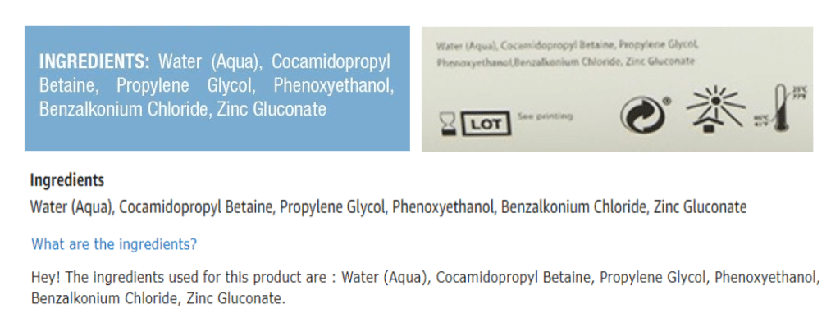
Two taken directly from the bottle and two from the Amazone details.
What does this mean?
My first reaction is “White Brand”, meaning there’s a factory out there making lube and companies are buying it and slapping their name on it. This isn’t necessarily a bad thing since the additives are on the “okay side”. However, since the factory wouldn’t belong to the brand, they wouldn’t have as much control over material quality.
VERDICT: Acceptable. Even though I wish I saw more green additives.
INGREDIENTS: Water (Aqua), Denatured Alcohol, Melaleuca Alternifolia, Leptospermum Petersonii, Lavandula Angustifolia, Decyl Glucoside, Polysorbate 40
VERDICT: I was surprised, but I shouldn’t have been. For some reason I always expect 50 Shades products to be crap, but, more often than not, they turn out to be alright (and better than a lot of other crap out there). If there’s no contamination of the Polysorbate 40, this would be #1 on the list.
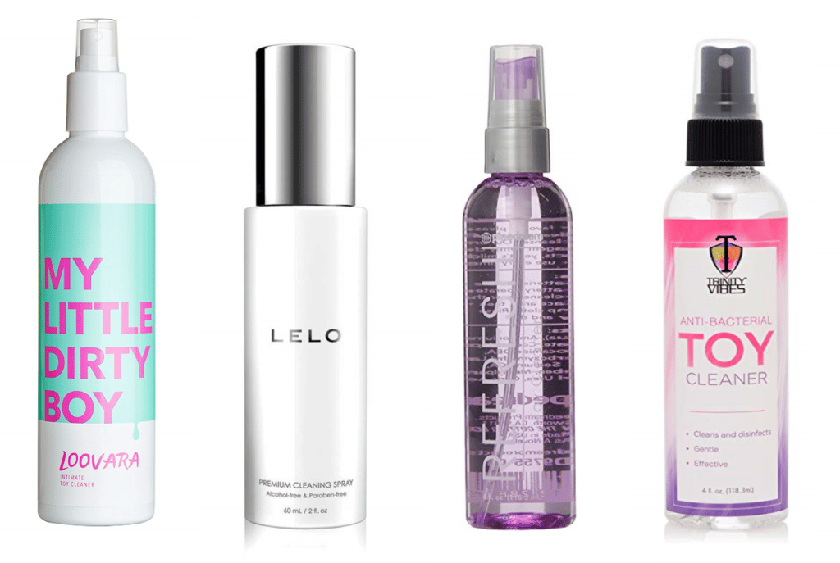
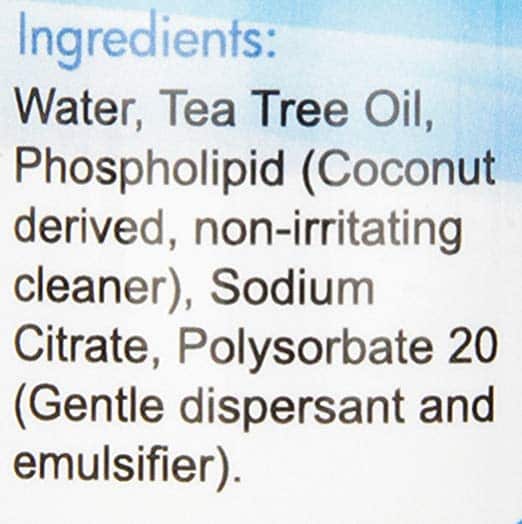
INGREDIENTS: Benzalkonium chloride, Propylene Glycol, Cocamidopropyl, Purified Water, Citric Acid, Zinc Gluconate
I guess there’s a “problem” here. The list that’s posted as part of the Amazon image preview is NOT the same as what’s listed on the bottle [image from preview].
VERDICT: I would have said that CleanStream was a strong contender and near the top of the list, but this error makes me think otherwise. Also, the purified water (on the bottle) isn’t the first ingredient, which makes me worry about the concentration.
INGREDIENTS: Deionized Water, Lauryldimoniumhydroxproply Decyglucosides, Deionized water, Chroide, PEG-8, Polysorbate 20, Stearygimoniumhydroxyproply Laurylglucosides Chloride, Phenoxyethanol, Caprylyl Glycol, Hydroxyethylcellulose, Pentylene Glycol, Citric Acid, Fragrance
VERDICT: That’s A LOT of red and yellow. I wouldn’t try it.
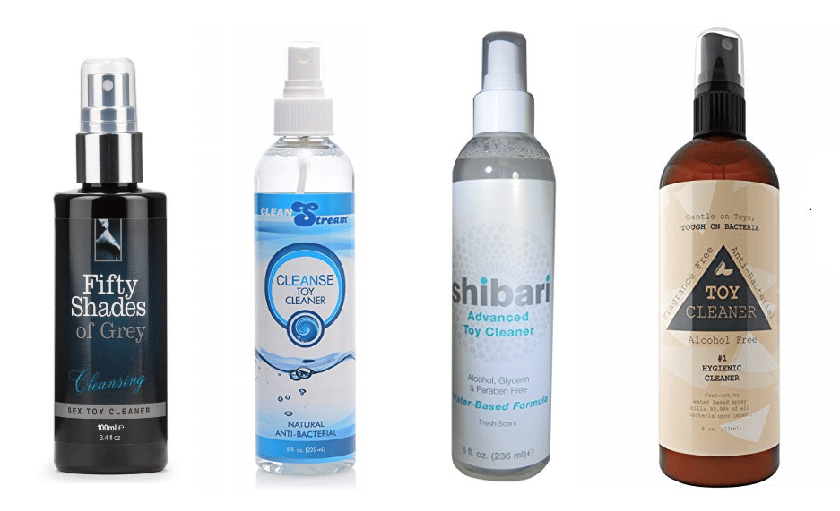
INGREDIENTS: Water, Glycerin, Sodium Lauryl Sulfate, Cocamidopropyl Betaine, Polysorbate 20, Phenoxyethanol, Benzalkonium Chloride, Lauryl Glucoside
VERDICT: The two questionable ingredients share the same problem – possible 1,4-dioxane contamination. If these ingredients were treated properly, this would be another decent cleaner. But since there’s no way to find out (I double the company would disclose the information), I’m sad to say I would recommend staying away from it until more info comes to light,.
MY DIRTY LITTLE BOY by LOOVARA
INGREDIENTS: Water, Aloe Barbadensis Leaf Juice, Allantoin, Propylene Glycol, Glycerin, Cocamidopropyl Betaine, Polyglyceryl-4 Caprate, Ethylhexylglycerin, Citric Acid, Sodium Citrate, Sodium Chloride, Sodium Benzoate*, Potassium Sorbate. (*Note, there’s no Vitamin C or ascorbic acid, so the Sodium Benzoate is fine)
However, another Amazon page with the same product (and sold by the same company) lists these additives:
Water, Propylene Glycol, *Heamidine (Hexamidine) Diisethionate, *Phenoyethanol (Phenoxyethanol), Neohesperidin Dihydro Chalcone, PEG-40 Hydrogenated Castor Oil, Parfum (Fragrance), Panthenol
VERDICT: I tend to go by what the back of the bottle tells me, but since I can find nothing in all the German that hints at this, I would err on the side of caution and avoid.
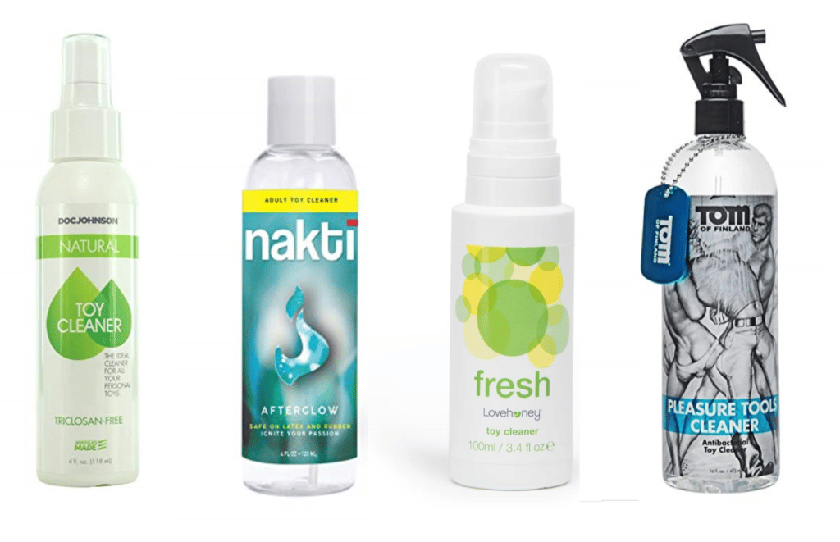
INGREDIENTS: Water, Propylene Glycol, Phenoxyethanol, Decyl Glucoside, PEG-7 Glyceryl Cocoate, PEG-12 Dimethicone, Sucralose, Sorbitol, Zinc Gluconate, Zinc Acetate, Zinc Lactate, Chlorhexidine Gluconate, Citric Acid, Disodium EDTA, Benzalkonium Chloride
VERDICT: Too many reds and yellows. I wouldn’t use it.
INGREDIENTS: Water (Aqua), Ammonium Lauryl Sulfate, Cocamidopropyl Betaine, Cocamide DEA, Sodium Carboxymethyl Lauryl Glucoside, Sodium PCA, Propylparaben, Methylparaben, Diazolidinyl Urea, Citric Acid
VERDICT: This Amazon site waves a bunch of red flags. The ingredients list is posted in the close-up image but it’s not the same as on the back of the bottle. The bottle ingredients don’t even have water as the first material. Plus, plenty of reds. Nope, I wouldn’t trust it.
INGREDIENTS:
Benzalkonium Chloride, Propylene Glycol, Cocamidopropyl Betaine, Phenoxyethanol, Purified Water, Citric Acid, Zinc Gluconate
VERDICT: We might have here is another white brand, since I found another cleaner (Tom of Finland Pleasures) to have the same list. But since the ingredients seem okay, I would give it a green light to test out.
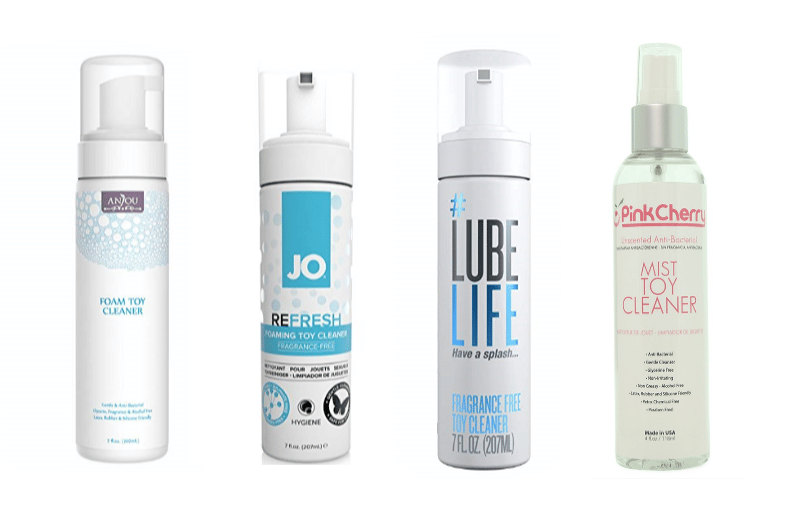
DOC JOHNSON NATURAL TOY CLEANER
INGREDIENTS: Water, Decyl Glucoside, Cocamidopropyl Hydroxysultaine, Sodium Lauroyl Sarcosinate, Fragrance, Disodium EDTA, Methylisothiazolinone, Methylchloroisothiazolinone
VERDICT: It doesn’t surprise me that this is crap. And it’s certainly not natural.
NAKTI AFTERGLOW
I can’t find a list of ingredients anywhere. Not in the description and no images of the back of the bottle. This product is only available in two places Amazon (through a company called LolliZ) or their main page (which also had no info). I had to email them directly and ask, but no answer. DO NOT BUY THIS PRODUCT.
INGREDIENTS: Aqua (Water), Decyl Glucoside, Cocamidopropyl Betaine, Sodium Chloride, Phenoxyethanol, Trisodium Ethylenediamine Disuccinate, Propylene Glycol, Methylisothiazolinone
VERDICT: Methylisothiazolinone is a possible carcinogen. At minimum, it might irritate sensitive skin. I wouldn’t, but it’s at your discretion.
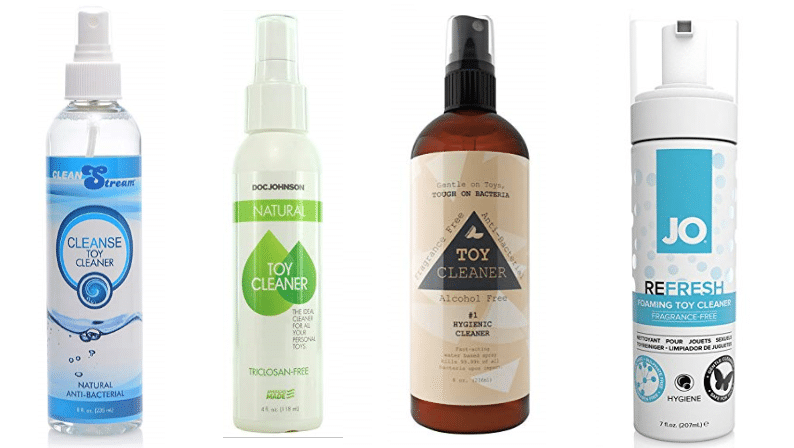
DETAILED CONCLUSIONS
It’s truly impossible to have a 100% definitive answer on what ingredients are safe for sex toy cleaning. There just hasn’t been any research on it. What might cause harm in allergic reactions or long-term use, might not have the same effect as a sex toy cleaner.
Then there are your personal feelings on the environment and chemicals.
The truth is…
Sex toy cleaner should NOT be your go-to washing method.
It’s also not good as an “emergency” cleaning if you want to share your toy with someone (remembering that you should never share toys with someone you don’t trust or hasn’t been tested – even then you should be putting a condom over it just in case).
And…
We can’t forget that none of this applies to POROUS toys – since the nature of the material means the antibacterial properties mean nothing and do nothing, and the toy will end up absorbing any toxic chemicals.
So, what’s best?
Mild soap plus warm water, careful cleaning, and the occasional sanitization with rubbing alcohol or 5-10% bleach solutions (with a rinse and air dry after) is always the best route.
Then why use sex toy cleaner at all?
You can’t always sanitize your toys while on vacation. After all, carrying around a canister of bleach in your suitcase is just weird (and maybe illegal, I don’t know). It this case, I find it useful. Also, when I want to have a deep cleaning, I like to use a sex toy cleaner as a stage after soap and before disinfecting. It’s another layer of hygiene for the germophobic.
What does all this mean?
It’s nice to have, but you don’t NEED it. And if you WANT it, at least get something that won’t cause a rash.
. . . . . . . . . . . . . . . . . . . .
Did you like this article? If so, you might like these other ones on “cleaning”…
- Buzzy and Clean! Over 30 Essential Tips on How to Clean Sex Toys
- 20+ Tips on How to Clean Leather – Keep Your BDSM Gear Shinning
- 12 Lessons You Must Learn About Latex Clothing
Anything you want to add? Share in the comments!

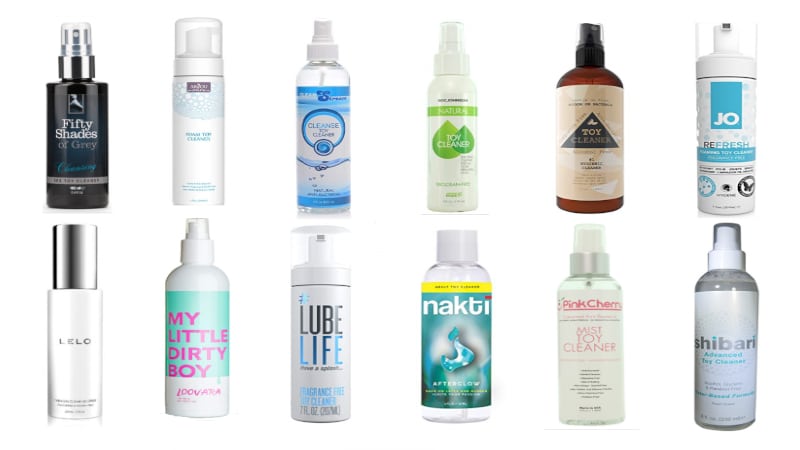

9 comments
What mild soaps would you recommend? Im not sure what soaps to use!
Key Ingredients
Water (Aqua)
Disodium Laureate Sulfosuccinate
Glycerin
Aloe Barbadensis Leaf Extract
Panthenol (Vitamin B5)
Melaleuca Alternifolia (Tea Tree) Leaf Oil
Water Based Non-Toxic Formula Cleans Toys – Fragrance-Free Paraben-Free Alcohol-Free Cruelty-Free 100% Pure Tea Tree Oil Natural
Soap & water works. An idea: How about a small spray bottle filled with Everclear? Everclear is available in many liquor stores, here in NH it costs about $18.50 for a fifth. Its 90% ethyl (grain) alcohol and Im assuming, 10% water. Denatured alcohol can have questionable stuff in it.
Hi Robyn,
Re Lovense Max2, there is a lot of do’s and don’t’s about cleaning this toy. Just so I have it correct, is any of the 15 toy cleaners OK?
The best advice is to follow the direction of the toy’s manual. They put all the specific details in there. Enjoy!
Robyn! Love this article! Im a sex therapist and podcaster and would love to talk more about this article. Is that something you would be game to do?? If so I can email you, or whatever you are comfortable doing. Thanks!!
Erika Miley
Sure, you can contact me at [email protected]
Really appreciate the thorough research and thoughtful recommendations! Robyn, do you have a twitter or do you write for other blogs? Would love to continue reading more of your stuff.
Thanks so much for the warm fuzzies, D.Ma 🙂 Currently I only write this blog but there are over 200 articles, so there might be more in there that interests you. As for Twitter, if you would like updates, you can follow the Lovense twitter account. They always update through there. /hugs